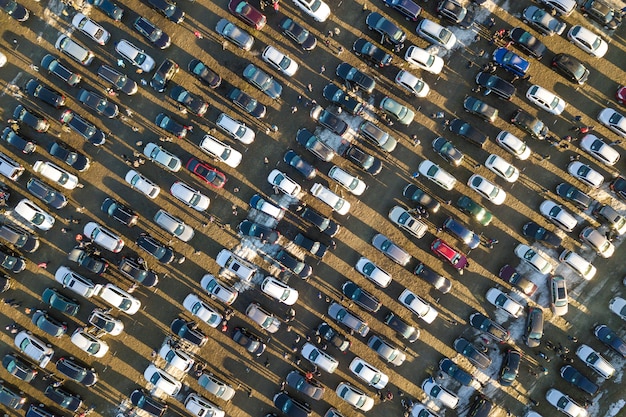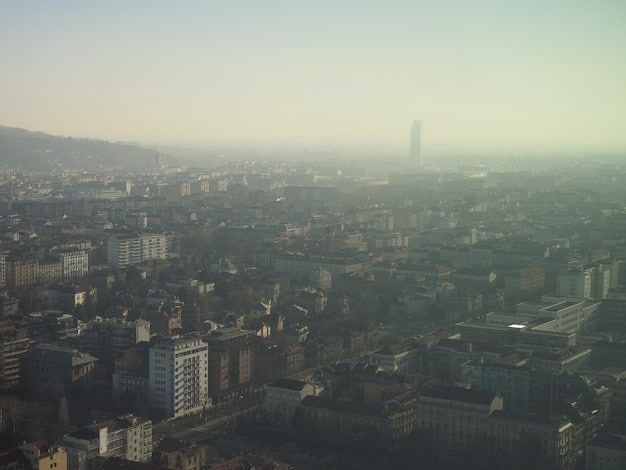Did You Know? Americans Wait 6 Months in Traffic

Did you know? The average American spends approximately six months of their life waiting in traffic, a staggering amount of time that highlights the pervasive issue of traffic congestion and its impact on daily life.
Have you ever felt like you spend more time in your car than anywhere else? Get ready for a shocking revelation: the average American spends a whopping 6 months of their life stuck in traffic. Let’s dive into what contributes to this staggering statistic and its impact on our lives, exploring the hidden costs of our daily commutes and potential solutions to reclaim this lost time. This seemingly unavoidable aspect of modern life has significant consequences, encompassing not only wasted time but also economic and environmental costs.
The Great American Traffic Jam: A Six-Month Sentence
Imagine spending half a year of your life simply waiting. Waiting for the light to change, waiting for the car in front of you to move, waiting for the highway to clear. For the average American, this isn’t a hypothetical scenario; it’s the reality of their daily commute. The statistic that Americans spend an average of six months of their lives waiting in traffic is not just a number; it’s a reflection of a deep-seated issue in our transportation systems and urban planning.
Let’s explore the various factors that contribute to this frustrating phenomenon and the ripple effects it has on our society.
Urban Sprawl and Commuting Patterns
One of the primary reasons for the immense amount of time spent in traffic is urban sprawl. As cities expand outward, people often move to suburban areas in search of affordable housing and larger living spaces. This leads to longer commutes as individuals travel greater distances to reach their workplaces in urban centers.
- Increased reliance on personal vehicles due to limited public transportation options in suburban areas.
- Concentration of workplaces in city centers, creating a daily influx of commuters.
- Inadequate infrastructure planning to accommodate the growing population and traffic volume.
The Economic Toll of Traffic Congestion
Beyond the sheer waste of time, traffic congestion carries a significant economic burden. The cost of fuel, vehicle wear and tear, and lost productivity all add up, impacting both individuals and the overall economy.
Consider these points:
- Increased fuel consumption due to idling and stop-and-go traffic.
- Higher maintenance costs for vehicles subjected to prolonged periods of slow-moving traffic.
- Lost productivity as employees arrive late to work or experience reduced focus due to stressful commutes.

In conclusion, the statistic that Americans spend six months of their lives in traffic highlights the urgent need for comprehensive solutions to address urban sprawl, improve public transportation, and reduce the economic and environmental impacts of congestion.
The Environmental Impact: Idling Towards Pollution
The environmental consequences of spending so much time idling in traffic are significant and far-reaching. The emissions from vehicles stuck in traffic contribute to air pollution, greenhouse gas emissions, and a range of health problems. Understanding these impacts is crucial for advocating for sustainable transportation alternatives.
Let’s delve into some key environmental concerns linked to traffic congestion.
Air Pollution and Respiratory Issues
Vehicles idling in traffic emit harmful pollutants such as carbon monoxide, nitrogen oxides, and particulate matter. These pollutants can exacerbate respiratory conditions like asthma and bronchitis and contribute to the formation of smog.
- Increased levels of ground-level ozone, a major component of smog, which can cause respiratory irritation and lung damage.
- Elevated concentrations of particulate matter, which can penetrate deep into the lungs and bloodstream, leading to cardiovascular and respiratory problems.
- Disproportionate impact on vulnerable populations, such as children, the elderly, and individuals with pre-existing respiratory conditions.
Greenhouse Gas Emissions and Climate Change
The emissions from vehicles in traffic also contribute to greenhouse gas emissions, which are a primary driver of climate change. Carbon dioxide, in particular, is a major greenhouse gas that traps heat in the atmosphere and contributes to global warming.
Moreover, carbon dioxide emissions can increase:
- Higher overall carbon footprint due to increased fuel consumption during traffic congestion.
- Acceleration of climate change impacts, such as rising sea levels, extreme weather events, and disruptions to ecosystems.
- Need for urgent action to reduce transportation-related emissions through sustainable alternatives.

In summary, the environmental impact of spending six months in traffic is profound, contributing to air pollution, greenhouse gas emissions, and a range of health problems. Addressing traffic congestion and promoting sustainable transportation alternatives is essential for mitigating these environmental consequences and creating a healthier, more sustainable future.
The Ripple Effect: Stress, Health, and Quality of Life
The impact of spending six months of one’s life in traffic extends far beyond the environmental and economic realms. The daily grind of commuting in congested conditions can have significant effects on stress levels, overall health, and quality of life. Let’s explore these interconnected aspects.
Stress and Mental Health
Navigating through traffic jams can be a highly stressful experience. The uncertainty, delays, and sense of being trapped can lead to increased levels of anxiety, frustration, and even road rage. Chronic stress from commuting can have long-term effects on mental health.
Keep in mind that:
- Elevated levels of cortisol, a stress hormone, which can contribute to a range of health problems, including high blood pressure and weakened immune function.
- Increased risk of developing anxiety disorders and depression due to the chronic stress of commuting.
- Negative impact on cognitive function, including reduced concentration and impaired decision-making.
Physical Health and Well-being
Prolonged periods of sitting in traffic can also take a toll on physical health. Lack of physical activity, poor posture, and exposure to air pollution can contribute to a range of health problems.
Also, consider these points:
- Increased risk of developing musculoskeletal problems, such as back pain, neck pain, and carpal tunnel syndrome, due to prolonged sitting and repetitive movements.
- Elevated risk of cardiovascular disease due to lack of physical activity and exposure to air pollution.
- Increased risk of obesity and related health problems due to sedentary lifestyle and unhealthy eating habits while commuting.
In conclusion, the ripple effect of spending six months of one’s life in traffic extends to stress, mental health, and quality of life. Addressing traffic congestion and promoting healthier, more sustainable transportation options is essential for improving the overall well-being of commuters and creating a more livable society.
The Time Sink: Lost Opportunities and Personal Sacrifices
The sheer amount of time that Americans spend waiting in traffic represents a significant loss of opportunities and potential for personal enrichment. Consider that six months of your life could be spent pursuing hobbies, spending time with loved ones, or engaging in activities that bring joy and fulfillment. Understanding this time sink can motivate individuals to seek alternatives and advocate for change.
Let’s dive into the various ways this lost time can impact personal lives.
Missed Family Time and Social Connections
Long commutes can cut into valuable time that could be spent with family and friends. The hours spent in traffic can mean missed dinners, school events, and other important social gatherings.
Moreover, it affects:
- Reduced opportunities for bonding and connection with family members.
- Decreased participation in social activities and community events.
- Feelings of isolation and disconnection from loved ones.
Career Development and Personal Growth
The time spent in traffic could be used for professional development, skill-building, or pursuing personal interests. The lost opportunities can hinder career advancement and personal growth.
Not to mention the following factors:
- Reduced time for attending workshops, seminars, and other professional development activities.
- Decreased opportunities for networking and building professional relationships.
- Limited time for pursuing hobbies, creative endeavors, and other personal interests.
Potential Solutions: Reclaiming Lost Time
While the statistic of spending six months in traffic may seem daunting, there are numerous potential solutions that can help Americans reclaim their lost time. These solutions range from technological innovations to policy changes to individual lifestyle adjustments. Let’s explore some promising strategies.
Technological Innovations: Smart Traffic Management
Advancements in technology offer opportunities to optimize traffic flow and reduce congestion. Smart traffic management systems can use real-time data to adjust traffic signals, reroute traffic, and provide drivers with up-to-date information.
- Adaptive traffic signals that adjust timing based on current traffic conditions.
- Real-time traffic information systems that provide drivers with alternative routes and estimated travel times.
- Autonomous vehicles that can communicate with each other to optimize traffic flow and reduce accidents.
Policy Changes: Investing in Public Transportation
Investing in public transportation infrastructure can provide commuters with a viable alternative to driving. Expanding bus and train networks, improving accessibility, and offering affordable fares can encourage more people to use public transportation.
Consider also that:
- Increased ridership on public transportation can reduce the number of vehicles on the road, alleviating traffic congestion.
- Improved accessibility to public transportation can make it easier for people to commute without a car.
- Affordable fares can make public transportation a more attractive option for low-income commuters.
Individual Actions: Shifting Commuting Habits
In addition to technological innovations and policy changes, individual actions can also play a significant role in reducing traffic congestion. Shifting commuting habits, such as telecommuting, carpooling, and using alternative modes of transportation, can make a big difference.
Below are some tips:
- Telecommuting allows employees to work from home, reducing the number of commuters on the road.
- Carpooling involves sharing a ride with others, reducing the number of vehicles on the road.
- Using alternative modes of transportation, such as biking, walking, or taking public transportation, can reduce reliance on personal vehicles.
| Key Aspect | Brief Description |
|---|---|
| 🚗 Commute Time | Americans average about 6 months of their lives stuck in traffic. |
| 💸 Financial Impact | Traffic jams increase fuel costs and reduce overall productivity. |
| 💨 Environmental Effects | Increased pollution leads to respiratory issues and global warming. |
| ⏳ Lost Time | Missed personal and professional opportunities. |
FAQ
▼
Americans spend approximately six months of their lives waiting in traffic, highlighting a significant issue of wasted time due to traffic congestion.
▼
Key factors include urban sprawl, dependence on personal vehicles, inadequate public transportation, and inefficient traffic management systems.
▼
Traffic contributes to air pollution through vehicle emissions, exacerbating respiratory issues and contributing to greenhouse gas emissions that drive climate change.
▼
Potential solutions include adopting smart traffic management technologies, enhancing public transportation options, and encouraging commuters to telecommute or carpool.
▼
Individuals can alleviate traffic by telecommuting, carpooling, using public transportation, biking, or walking, thereby reducing the number of vehicles on the roads.
Conclusion
In conclusion, the fact that the average American spends approximately six months of their life in traffic is a staggering statistic that underscores the need for comprehensive solutions. From technological innovations and policy changes to individual actions, addressing traffic congestion requires a multifaceted approach to reclaim lost time, reduce environmental impacts, and improve overall quality of life.





